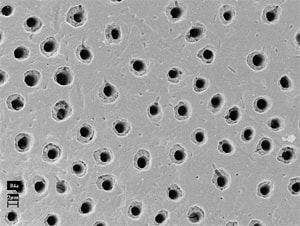What is it?
Tooth sensitivity is something that affects a number of people. It is often caused by eating or drinking something hot, cold, sweet or acidic. Under normal conditions, the underlying dentin of the tooth (the layer that immediately surrounds the nerve) is covered by the enamel in the tooth crown, and the gums that surround the tooth. Over time, the enamel covering can get thinner, thus providing less protection. The gums can also recede over time, exposing the underlying root surface dentin.
The dentin contains a large numbers of pores or tubes that run from the outside of the tooth to the nerve in the center. When the dentin is exposed, these tubes can be stimulated by changes in temperature or certain foods. Here is an image of what the dentin tubes look like under the microscope:

What causes it?
Exposure of the dentin can occur due to a number of factors. Some of the more common reasons are:
- Gum recession due to age or improper tooth brushing
- Acidic beverages (such as soda) that cause enamel erosion and dentin exposure
- Tooth grinding – this may actually cause most or all of the teeth to feel sensitive
- Brushing with a very abrasive toothpaste, brushing incorrectly and/or brushing more than three times a day could result in a loss of enamel
- Gum disease, which can result in gum recession
- A chipped or fractured tooth may expose the dentin
In addition, some dental treatments can cause sensitivity. Treatments such as such as teeth whitening, professional dental cleanings, having braces put on or getting a filling placed have been known to cause sensitivity during or after the procedure.
What can I do about it?
The first step in doing something about dental sensitivity is to find out what the cause is – a dental professional can help you with this. If the sensitivity is due to exposed dentin, there are a number of steps you can take, as can your dental professional, to help reduce the sensitivity. These can include:
- Using a very soft bristle tooth brush
- Brushing correctly to help prevent abrasion of the enamel and recession of the gums
- Using a toothpaste specially formulated to help reduce sensitivity
- The dental professional can:
- Apply a fluoride varnish on the sensitive areas to help strengthen the tooth
- Prescribe a high fluoride tooth paste to use every day
- Place a dental restoration to build up the areas that have lost enamel
In the end, whether you need an in-office procedure or over-the-counter products, the most important step is to see a dental professional so that he or she can determine the cause of the tooth sensitivity and help you find a solution that will work.
11/15/2010
This article is intended to promote understanding of and knowledge about general oral health topics. It is not intended to be a substitute for professional advice, diagnosis or treatment. Always seek the advice of your dentist or other qualified healthcare provider with any questions you may have regarding a medical condition or treatment.
ORAL HEALTH QUIZ
What's behind your smile?
Take our Oral Health assessment to get the most from your oral care routine
ORAL HEALTH QUIZ
What's behind your smile?
Take our Oral Health assessment to get the most from your oral care routine












